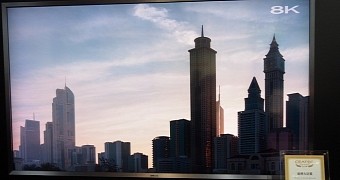The latest resolution level to be achieved by monitors and TVs, as well as the graphics cards and processors that drive them, is 4K, or 3840 x 2160 pixels and its variations. However, an 8K display already exists, which has, in turn, raised the question of what NVIDIA and AMD intend to do in regards to the video standard.
The answer is “not much.” Both companies see 8K resolution as a great challenge but not one they believe can be overcome on single graphics processors any time soon.
As for multi-graphics situations, they do admit it is feasible, but only if they jump through a few hoops when modifying the firmware and drivers. And even then it won't be the best 4K quality possible.
The Sharp 8K display
This is a product that can definitely qualify as “before its time.” Having been released at the CEATEC trade show held recently in Japan, it has a resolution of 7,680 x 4,320 pixels.
Thus, it has four times as many pixels as a 4K monitor / television set. It kind of raises the question of what it is supposed to be used for.
Since there are no graphics chips with the ability to render video at that level, the product has to make do with software-based upscaling. Even TV broadcast services are unable to send out channels in that quality.
One could argue that the Japanese company really dropped the ball on that one, but it's undeniable that it did earn it some fame in the short-term, as well as the title of bar setter for the next big thing in display technology.
It’s curious really that it happened so fast. 4K Ultra HD is only now starting to enter the consumer mainstream, and even that's a bit of a stretch given the prices of LCDs featuring it.
Why AMD and NVIDIA can't support 8K right now
Their GPUs would need two TDMS links to drive 8K over DVI, while the DisplayPort 1.2 and HDMI 2.0 technologies can't do better than UHD at 60 Hz at the moment.
In a year or two, this might change, especially once the next generation of AMD and NVIDIA boards debuts, though the standard setters for video output connectors might have to accelerate their development plans a bit too.
In the meantime, it should theoretically be possible to enable 8K through multi-monitor configurations, and only if you have more than one GPU inside your PC. The Sharp display (and any other 8K monitor) would be treated as a set of four monitors. Kind of like how SSD caching technologies fool a PC into thinking an SSD and HDD duo are a single product, only in reverse.

 14 DAY TRIAL //
14 DAY TRIAL //